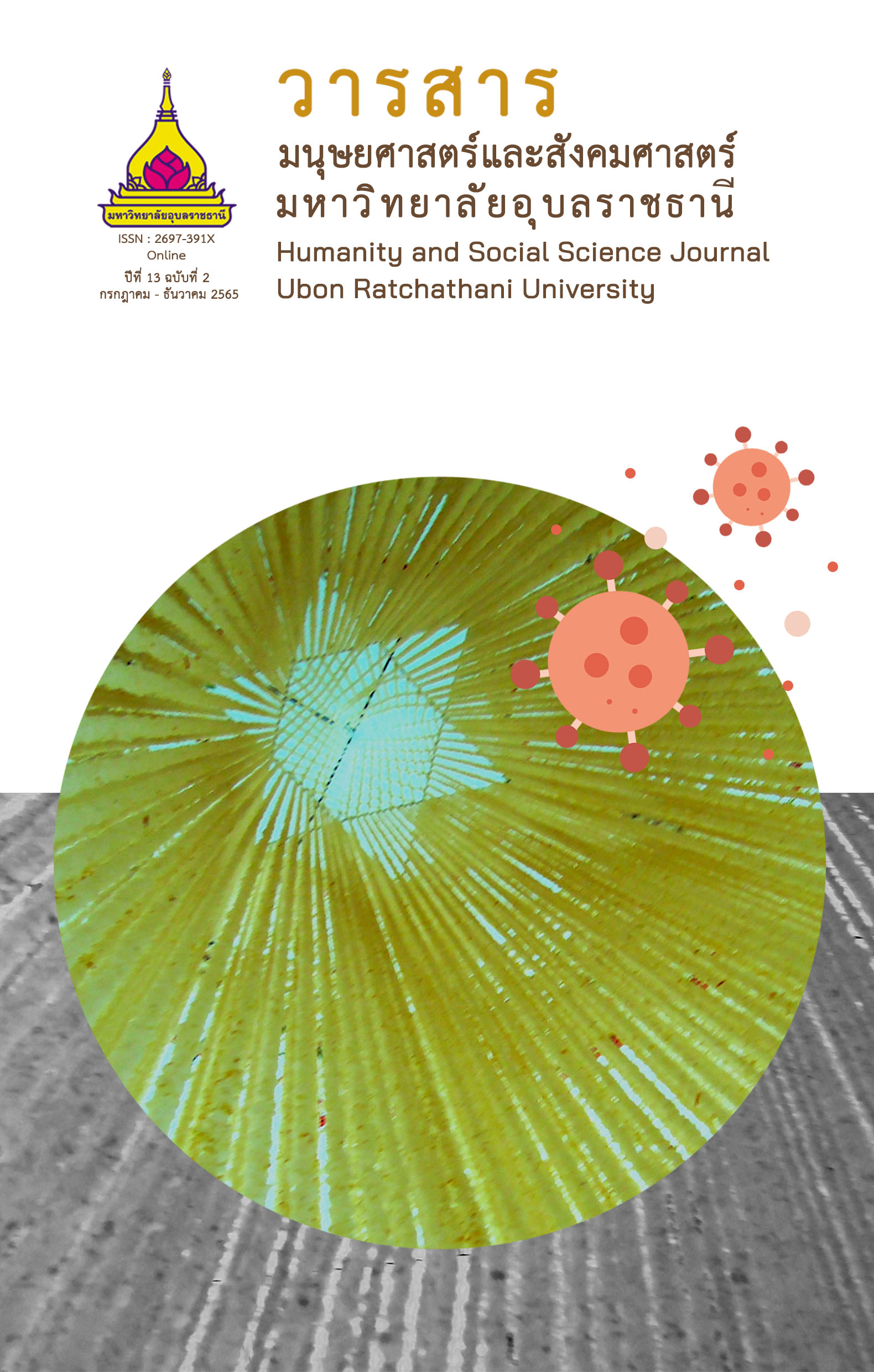‘เถ้าแก่อีสาน’ ในเมืองกรุง: แรงปรารถนาของผู้คน ชุมชน และการพัฒนาชนบท
Main Article Content
บทคัดย่อ
บทความนี้ศึกษาแรงงานย้ายถิ่นจากชนบทไปประกอบอาชีพในกรุงเทพฯและปริมณฑล และสามารถพัฒนาตนเองเป็นผู้ประกอบการที่มีฐานะมั่นคง ซึ่งในบทความเรียกคนเหล่านี้ว่า “เถ้าแก่” โดยทำการศึกษาวิจัยเชิงคุณภาพ เก็บข้อมูลในหมู่บ้านต้นทางของเถ้าแก่ในจังหวัดภาคอีสาน และติดตามไปสัมภาษณ์และสังเกตการณ์กิจการของเถ้าแก่ในกรุงเทพฯและปริมณฑล ด้วยการใช้มโนทัศน์แรงปรารถนาตามแนวทางของพัฒนา กิติอาษา บทความพบว่าชาวบ้านอีสานไม่แตกต่างจากผู้คนทั่วไป คือมีแรงปรารถนายกระดับคุณภาพชีวิตและสถานะทางสังคม กลุ่มคนที่ประสบความสำเร็จเป็นเถ้าแก่มีปัจจัยความสำเร็จคือ บริบทเชิงโครงสร้างที่เอื้ออำนวย กลไกเชื่อมโยงระหว่างโครงสร้าง-ผู้กระทำการ และคุณสมบัติพิเศษส่วนบุคคล รวมทั้งพบว่าแรงปรารถนาระดับบุคคลเชื่อมโยงกับแรงปรารถนาระดับชุมชน ดังเห็นได้จากกรณีตัวอย่างโครงการพัฒนาชุมชน ซึ่งบุคคลสำคัญในชุมชนใช้โครงการเป็นช่องทางสร้างโอกาสทางสังคมตนเอง ขณะเดียวกันโครงการได้ช่วยพัฒนาชุมชนด้วย บทความเสนอว่าแนวทางการศึกษากลุ่มคนในฐานะผู้กระทำการทางสังคม โดยให้ความสนใจมิติความรู้สึก จินตนาการ และประสบการณ์ ควรได้รับความสนใจมากขึ้น เพราะช่วยให้เข้าใจความคิดจิตใจของกลุ่มทางสังคมประเภทต่าง ๆ และกำหนดนโยบายการพัฒนาได้เหมาะสมมากขึ้น
Article Details

อนุญาตภายใต้เงื่อนไข Creative Commons Attribution-NonCommercial-NoDerivatives 4.0 International License.
บทความที่ได้รับการตีพิมพ์เป็นลิขสิทธิ์ของวารสารมนุษยศาสตร์และสังคมศาสตร์ มหาวิทยาลัยอุบลราชธานี
ข้อความที่ปรากฏในบทความแต่ละเรื่องในวารสารวิชาการเล่มนี้เป็นความคิดเห็นส่วนตัวของผู้เขียนแต่ละท่านไม่เกี่ยวข้องกับมหาวิทยาลัยอุบลราชธานี และคณาจารย์ท่านอื่นๆในมหาวิทยาลัยฯ แต่อย่างใด ความรับผิดชอบองค์ประกอบทั้งหมดของบทความแต่ละเรื่องเป็นของผู้เขียนแต่ละท่าน หากมีความผิดพลาดใดๆ ผู้เขียนแต่ละท่านจะรับผิดชอบบทความของตนเองแต่ผู้เดียว
เอกสารอ้างอิง
Boonmathya, R. (1977). Contesting concept of development in rural northeastern Thailand. Unpublished PhD dissertation. University of Washinton.
Chamaratana, T. Ayuwat, D. & Chinnasri, O. (2011). Connecting the disconnected: social network of isan labor brokers. Journal of Mekong Societies, 7(3), 27-52. (in Thai)
Charoensin-o-larn, C. (2012). The politics of desire. Bangkok: Pitak Aksorn Publisher. (in Thai)
Ek-Iem, B. (2019) Migration: The Establishing and Maintaining of Social Networks of Women Burmese Migrant Workers in Chiang Mai City. Mekong-Salween Civilization Studies Journal, 10(1), 13-38. (in Thai)
Gidden, A. (1984). The constitution of society: outline of the theory of structuration. California: University of California Press.
Gilles, D. & Guattarinti, F. (1983). Oedipus: capitalism and schizophrenia. Minnesota: University of Minnesota Press.
Gilles, D. & Guattarinti, F. (1987). A thousand plateaus: capitalism and schizophrenia, Minnesota: University of Minnesota Press.
Keyes, C. F. (1967). Peasant and nation: a Thai Lao village in a Thai state. unpublished PhD dissertation, Cornell University, Ithaca, NY.
Kirsch, T. A. (1966). Development and mobility among the Phu Thai of northeast Thailand. Asia Survey, 6(7), 370-378.
Kitiarsa, P. (2014). Isan becoming: agrarian change and the sense of mobile community. Bangkok: Vibhasa. (in Thai)
Lapanun, P. (2015). ‘Mea Farang’: Formation of new classes in (rural) Thailand. In C. Vittayapak. (Ed.). Culture is power: Operations of new power, identity and class in cultural areas. (pp. 271-299). Chiang Mai: Faculty of Social Sciences, Chiang Mai University. (in Thai)
Nartsupha, C. (1991). The community culture school of thought. In M. Chitakasem & A Turton. (Eds), Thai Construction of Knowledge. (pp. 118-141). London: School of Oriental and African Studies, University of London.
National Statistical Office. (n.d.). Average monthly income per household by province 2004 – 2021. Retrieved November 7, 2021. From http://statbbi.nso.go.th/staticreport/Page/ sector/ TH/report/sector_08_4_TH_.xlsx. (in Thai)
Nattayarak, P. & Ondum, B. (1992). Evolution of arable land reclamation in the Northeastern Forest. In C. Phinthong. (Ed.) Evolution of arable land reclamation in the forest area. (pp.169-236). Bangkok: Local Community Development Institute. (in Thai)
Niyomsilpa, S. (2006). The end of Thai automotive millionaires. In P. Phongpichit. (Ed.). The battle of Thai capitalist, adaptation and dynamics. (pp. 209-299). Bangkok: Matichon Publishing House. (in Thai)
Office of Agricultural Economics (n.d.). Indicators of economic conditions, society, agricultural households. Retrieved November 7, 2021. from https://www.oae.go.th/assets/portals/1/files/socio/socio10june63.pdf. (in Thai)
Phatharathananunth, S. (2012). A. Maneeroj, (translator). Politics of the post-peasant society: Conditions for the formation of red shirts in the Northeast. (pp. 123-142). Far Deaw Kun, 10(2), 123-142. (in Thai)
Phongpichit, P. & Baker, C. (2003). Thai political economy in the Bangkok period. Chiang Mai: Silkworm Books. (in Thai)
Rigg, J. (2005). Poverty and livelihoods after full-time farming: A South-East Asian view. Asia Pacific Viewpoint, 46(2), 173-184.
Rigg, J, & Salamanca, A. (2011). Connecting lives and places: Mobility and spatial signatures in Northeast Thailand, 1982-2009. Critical Asian Studies, 43(4), 551-75.
Santasombat, Y. (2008). Flexible peasants: Reconceptualizing the third world’s rural types. Chiang Mai: Regional Center for Social Science and Sustainable Development (RCSD), Chiang Mai University Press.
Therasasawat, S. (2003). Economic history of Isan village community. Bangkok: Sarngson Publisher. (in Thai)
Thongyou, M & Ayuwat, D. (2005). Social Network of Lao Transnational Migrant Workers in Thailand. Journal of Mekong Societies, 1(2), 55-83. (in Thai)
Walker, A. (2016). J. Sangkamanee. (translator). Thailand’s Political Peasants: Power in the Modern Rural Economy. Nonthaburi: Samesky Books. (in Thai)
Yongpisarnpop, V. (2018). Auto parts industry. Krungsri Resersch. Retrieved May 10, 2019, from https://bit.ly/31xY9tm (in Thai)


